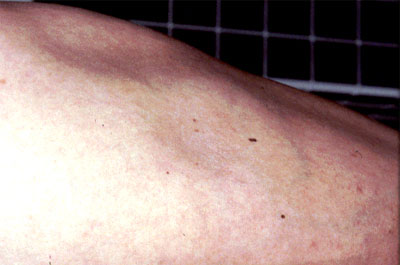|
|
|
Systemic lupus erythematosus
Systemic lupus erythematosus (SLE) is an immunological disease involving a host of internal organs, including the skin.
Occasionally triggered by drug exposure, most cases of SLE remain idiopathic.
Skin lesions are present in perhaps 80% of patients with SLE.
The characteristic hallmark is a diffuse erythema of the malar skin, the so-called butterfly rash. Most commonly manifested during an acute exacerbation of SLE, this eruption can extend well beyond the malar areas in some patients.
Patients with SLE may also develop lesions quite typical of those seen in discoid lupus erythematosus. Other skin lesions include papulosquamous changes consistent with those seen in subacute cutaneous lupus erythematosus.
Skin lesions can blister, particularly after exposure to ultraviolet light. Most patients note a marked worsening after exposure to ultraviolet light.
Evidence of vasculitis may be present with punctate hemorrhages involving the digits including nail bed. Ulceration of nodose lesions can also occur.
A diffuse non-scarring alopecia can occur during exacerbations of SLE as well as classical areas of scarring discoid lupus erythematosus.
Panniculitis (LE profundus) can occur.
Women are much more frequently affected than men.
Four of the eleven following American Rheumatism Association criteria are strongly suggestive of the diagnosis of lupus erythematosus.
- malar rash
- discoid rash
- photosensitivity
- oral ulcers
- non-erosive arthritis
- pleural serositis or pericarditis
- renal disease, persistent proteinuria
- psychosis or seizures
- evidence of bone marrow depression
- positive LE cell, anti-DNA, anti-SM antibody, false positive serology for syphilis
- anti-nuclear antibodies
Treatment:
- Patients with SLE should be managed by physicians who are competent to assess and follow their many systemic problems.
- Systemic therapy with immunosuppressants such as azathioprine and/or moderately high doses of prednisone, may be required.
- Patients with SLE should avoid exposure to excessive ultraviolet light. The routine use of a broad spectrum sunscreen covering both ultraviolet A and B is to be recommended.
- Care of local skin lesions is discussed under DLE and subacute LE.

Back to Dermatology Glossary - S Index |
Back to Dermatology Glossary Index
|